All about weeping rowan

Rowan is a popular plant both among gardeners and landscape designers. Recently, the so-called weeping mountain ash is gaining popularity. It is worth considering its main characteristics and cultivation features.
Description
The main habitat of the weeping mountain ash is the temperate climatic zone of the country. Standard Features:
- crown type - spreading;
- crown shape - round and openwork;
- height - up to 6-8 meters;
- shoots are red-brown in youth and yellowish-gray as they mature, smooth;
- leaf plates are dark green, up to 20 cm long;
- flowers are white, in the form of scutes in the inflorescence.
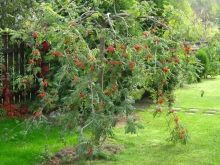
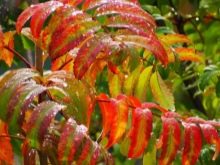
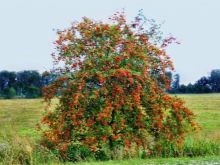
Towards the end of the summer season, mountain ash forms small orange-red berries with a diameter of up to 1.2 cm. Fruits have a variety of tastes: from too sour taste to slightly bitter and even sweetish. It is worth noting that most varieties are used mainly for decorative purposes, because the berries are not suitable for consumption.
Pendula has increased resistance to frost, so it can easily endure winter, even in its most severe manifestations. Also, the tree is able to withstand drought. Such properties ensured a high demand for mountain ash in many regions of the country. Today the tree can be found both in the central part of Russia and in the Urals and even the Far East.
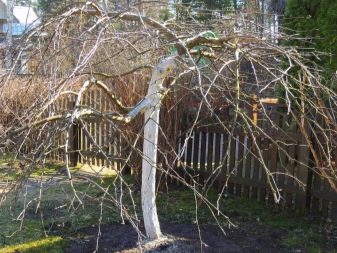

How to make a form?
An interesting fact: the shape of the weeping crown is not inherited, but is formed by the gardener independently. You can start forming only after the tree reaches the age of 8-10 years. With a young seedling, it will not work out what was planned, as well as with an over-grown tree. Many gardeners who have not yet experienced a similar procedure think that it is difficult. But in fact, everything is easy if the direction of growth of the branches is determined in a timely manner. It is important that the already strengthened shoots look in one direction. It is worth starting to form a tree closer to the beginning of the season: in March or April. You can also make a weeping mountain ash in the fall, around the last days of September. The main stages will be as follows.
- To grow a weeping mountain ash, you will need to prepare materials and tools, including wooden pegs, rope and wire.
- Next, the largest branches of the tree are carefully bent down, doing this sequentially with each element. All branches must be bent in one direction.
- During the deformation of the shoots, make sure that the bark does not break. In this case, it is taken into account that the branches should be pressed as much as possible to the ground.
- Then the branches are released for a while and the places for the installation of the pegs are marked.
- Wooden racks are installed on marked areas, and then branches are tied to them using a strong rope.
- The ropes are removed after a year. This is enough for the mountain ash to take on a weeping look.
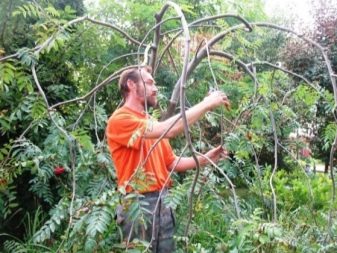
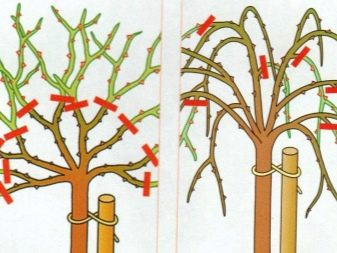
Gardeners advise using wire if you have to bend rather tight branches to the ground. But this option is possible only as a last resort, if you cannot cope with the rope, since metal can harm wood.
There is another way to quickly form the crown of a tree. This is a vaccination that will allow you to get several young shoots. Of these, it will subsequently be possible to form a weeping look. The advantage of this method is that it is suitable for young trees aged 3 to 5 years.It is important that the trunk diameter is more than 2 cm. The diagram looks like this.
- First of all, its own shoots are removed from the trunk, which is planned to be grafted. In this case, the central branches are cut so that the stem (this is its bare part) is high.
- Next, they take the prepared cuttings and begin to graft them, placing them close to each other.
- During the year, buds are removed from the tree and shoots, allowing the grafted cuttings to take root.
- In the second year, when the shoots are strong enough, they are bent to the ground and tied with a rope to the exposed pegs.
Three years later, the rowan is cut off, leaving 4 buds on each branch.


Planting and leaving
It is recommended to plant rowan in fertile soil, where the tree will take root faster. Although, if necessary, you can plant a plant in infertile soil.
Particular attention should be paid to care.
- Formation. In the early years, shoots that are too long should be cut off, and after tying to the pegs, it is recommended to watch that the bark does not crack.
- Watering. In the first years, it is necessary to bring up to 3 buckets under the trunk 1-2 times a month to ensure active growth of the culture. Mature trees do not require watering, only in a drought, the tree should be watered with 5-6 buckets once a month.
- Top dressing. The first 2 years, while the mountain ash is growing, it is necessary to fertilize the soil with manure or other organic components. Then preference is given to mineral and complex compositions. In the fall, when the dormant period begins, potassium or superphosphate is introduced into the soil.
- Loosening. You should dig the soil around the rowan trunk every quarter. It is necessary to loosen the soil to a thickness of at least 5 cm in order to ensure the necessary flow of oxygen to the roots of the plant. In the spring, it is additionally worth mulching the trunk circle so that the mountain ash receives a generous supply of nutrients.
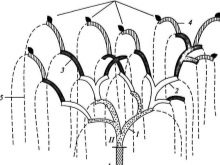


It is not necessary to prepare mountain ash for winter. However, gardeners advise covering young seedlings with dense material or special agrofibre, which can be purchased at a gardening store. You can also use leaves or burlap.
Weeping mountain ash is considered one of the most attractive tree species, whose crown is not formed naturally, but through a series of simple procedures. Even an inexperienced gardener can cope with the task, so the plant is popular in landscape design and is often found in garden plots.

Use in landscape design
Weeping rowan trees are quite common among landscape designers. Possible uses of culture look like this.
- Arrangement of open spaces. Looks beautiful when the branches of the mountain ash are freely scattered.
- Disembarkation of single landings. Rowan trees look good in such compositions due to the eye-catching crown.
- Garden decoration. Planting of mountain ash is especially relevant in areas of country houses, where a perennial tree, thanks to its crown, can act as a New Year tree.
Recently, dwarf variants of weeping rowan trees have been popular, which look attractive in large-scale plantings among flowers and forbs.
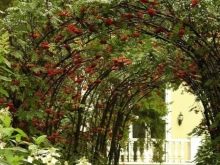

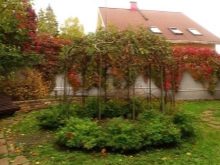



































































The comment was sent successfully.